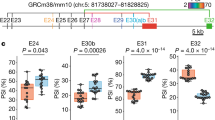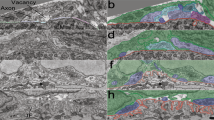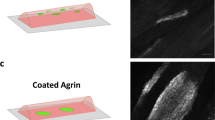Abstract
Precise apposition of pre- to postsynaptic specializations is required for optimal function of chemical synapses, but little is known about how it is achieved. At the skeletal neuromuscular junction, active zones (transmitter release sites) in the nerve terminal lie directly opposite junctional folds in the postsynaptic membrane. Few active zones or junctional folds form in mice lacking the laminin β2 chain, which is normally concentrated in the synaptic cleft. β2 and the broadly expressed γ1 chain form heterotrimers with α chains, three of which, α2, α4 and α5, are present in the synaptic cleft. Thus, α2β2γ1, α4β2γ1 and α5β2γ1 heterotrimers are all lost in β2 mutants. In mice lacking laminin α4, active zones and junctional folds form in normal numbers, but are not precisely apposed to each other. Thus, formation and localization of synaptic specializations are regulated separately, and α4β2γ1 (called laminin-9) is critical in the latter process.
This is a preview of subscription content, access via your institution
Access options
Subscribe to this journal
Receive 12 print issues and online access
$209.00 per year
only $17.42 per issue
Buy this article
- Purchase on Springer Link
- Instant access to full article PDF
Prices may be subject to local taxes which are calculated during checkout







Similar content being viewed by others
References
Sanes, J. R. & Lichtman, J. W. Development of the vertebrate neuromuscular junction. Annu. Rev. Neurosci. 22, 389–442 (1999).
Noakes, P. G., Gautam, M., Mudd, J., Sanes, J. R. & Merlie, J. P. Aberrant differentiation of neuromuscular junctions in mice lacking s-laminin/laminin β2. Nature 374, 258–262 (1995).
Burgess, R. W., Nguyen, Q. T., Son, Y. J., Lichtman, J. W. & Sanes, J. R. Alternatively spliced isoforms of nerve- and muscle-derived agrin: their roles at the neuromuscular junction. Neuron 23, 33–44 (1999).
Patton, B. L., Miner, J. H., Chiu, A. Y. & Sanes, J. R. Localization, regulation and function of laminins in the neuromuscular system of developing, adult and mutant mice. J. Cell Biol. 139, 1507–1521 (1997).
Colognato, H. & Yurchenco, P. D. Form and function: the laminin family of heterotrimers. Dev. Dyn. 218, 213–234 (2000).
Sanes, J. R., Marshall, L. M. & McMahan, U. J. Reinnervation of muscle fiber basal lamina after removal of myofibers. Differentiation of regenerating axons at original synaptic sites. J. Cell Biol. 78, 176–198 (1978).
Hunter, D. D., Shah, V., Merlie, J. P. & Sanes, J. R. Laminin-like adhesive protein concentrated in the synaptic cleft of the neuromuscular junction. Nature 338, 229–234 (1989).
Sanes, J. R., Engvall, E., Butkowski, R. & Hunter, D. D. Molecular heterogeneity of basal laminae: isoforms of laminin and collagen IV at the neuromuscular junction and elsewhere. J. Cell Biol. 111, 1685–1699 (1990).
Porter, B. E., Weis, J. & Sanes, J. R. A motoneuron-selective stop signal in the synaptic protein, s-laminin. Neuron 14, 549–559 (1995).
Cho, S. I., Ko, J., Patton, B. L., Sanes, J. R. & Chiu, A. Y. Motor neurons and Schwann cells distinguish between synaptic and extrasynaptic isoforms of laminin. J. Neurobiol. 37, 339–358 (1998).
Son, Y. J., Patton, B. L. & Sanes, J. R. Induction of presynaptic differentiation in cultured neurons by extracellular matrix components. Eur. J. Neurosci. 11, 3457–3467 (1999).
Patton, B. L., Chiu, A. Y. & Sanes, J. R. Synaptic laminin prevents glial entry into the synaptic cleft. Nature 393, 698–701 (1998).
Martin, P. T., Ettinger, A. M. & Sanes, J. R. A synaptic localization domain in the synaptic cleft protein laminin β2 (s-laminin). Science 269, 413–416 (1995).
Reese, T. et al. Cytoprotection does not preserve brain functionality in rats during the acute post-stroke phase despite evidence of non-infarction provided by MRI. NMR Biomed. 13, 361–370 (2000).
Ringelmann, B. et al. Expression of laminin alpha1, alpha2, alpha4, and alpha5 chains, fibronectin, and tenascin-C in skeletal muscle of dystrophic 129Rej dy/dy mice. Exp. Cell Res. 246, 165–182 (1999).
Patton, B. L. et al. Distribution of ten laminin chains in dystrophic and regenerating muscles. Neuromuscul. Disord. 9, 423–433 (1999).
Marques, M. J., Conchello, J. A. & Lichtman, J. W. From plaque to pretzel: fold formation and acetylcholine receptor loss at the developing neuromuscular junction. J. Neurosci. 20, 3663–3675 (2000).
Miner, J. H. et al. The laminin α chains: Expression, developmental transitions, and chromosomal locations of α1–5, identification of heterotrimeric laminins 8–11, and cloning of a novel α3 isoform. J. Cell Biol. 137, 685–701 (1997).
Matthews-Bellinger, J. A. & Salpeter, M. M. Fine structural distribution of acetylcholine receptors at developing mouse neuromuscular junctions. J. Neurosci. 3, 644–657 (1983).
Gilbert, J. J., Steinberg, M. D. & Banker, B. Q. Ultrastructural alterations of the motor end plate in myotonic dystrophy of the mouse (dy2J dy2J). J. Neuropathol. Exp. Neurol. 32, 345–364 (1973).
Law, P. K., Saito, A. & Fleischer, S. Ultrastructural changes in muscle and motor end-plate of the dystrophic mouse. Exp. Neurology 80, 361–382 (1983).
Grady, R. M. et al. Maturation and maintenance of the neuromuscular synapse: genetic evidence for roles of the dystrophin glycoprotein complex. Neuron 25, 279–293 (2000).
Bloch, R. J. & Pumplin, D. W. Molecular events in synaptogenesis: nerve–muscle adhesion and postsynaptic differentiation. Am. J. Physiol. 254, C345–364 (1988).
Prokop, A., Landgraf, M., Rushton, E., Broadie, K. & Bate, M. Presynaptic development at the Drosophila neuromuscular junction: assembly and localization of presynaptic active zones. Neuron 17, 617–626 (1996).
Grady, R. M. et al. Role for α-dystrobrevin in the pathogenesis of dystrophin-dependent muscular dystrophies. Nat. Cell Biol. 1, 215–220 (1999).
Sunderland, W. J., Son, Y. J., Miner, J. H., Sanes, J. R. & Carlson, S. S. The presynaptic calcium channel is part of a transmembrane complex linking a synaptic laminin (α4β2γ1) with non-erythroid spectrin. J. Neurosci. 20, 1009–1019 (2000).
Son, Y. J. et al. The synaptic vesicle protein SV2 is complexed with an α5-containing laminin on the nerve terminal surface. J. Biol. Chem . 275, 451–460 (2000).
Robitaille, R., Adler, E. M. & Charlton, M. P. Strategic location of calcium channels at transmitter release sites of frog neuromuscular synapses. Neuron 5, 773–779 (1990).
Cohen, M. W., Jones, O. T. & Angelides, K. J. Distribution of Ca2+ channels on frog motor nerve terminals revealed by fluorescent omega-conotoxin. J. Neurosci. 11, 1032–1039 (1991).
Cohen, M. W., Hoffstrom, B. G. & DeSimone, D. W. Active zones on motor nerve terminals contain α3β1 integrin. J. Neurosci. 20, 4912–4921 (2000).
Miner, J. H., Cunningham, J. M. & Sanes, J. R. Roles for laminin in embryogenesis: exencephaly, syndactyly, and placentopathy in mice lacking the laminin α5 chain. J. Cell Biol. 143, 1713–1723 (1998).
Meriney, S. D., Wolowske, B., Ezzati, E. & Grinnell, A. D. Low calcium-induced disruption of active zone structure and function at the frog neuromuscular junction. Synapse 24, 1–11 (1996).
Wood, S. J. & Slater, C. R. The contribution of postsynaptic folds to the safety factor for neuromuscular transmission in rat fast- and slow-twitch muscles. J. Physiol. (Lond.) 500, 165–176 (1997).
Uteshev, V. V., Patlak, J. B. & Pennefather, P. S. Analysis and implications of equivalent uniform approximations of nonuniform unitary synaptic systems Biophys J. 79, 2825–2839 (2000).
Xie, X., Liaw, J. S., Baudry, M. & Berger, T. W. Novel expression mechanism for synaptic potentiation: alignment of presynaptic release site and postsynaptic receptor. Proc. Natl. Acad. Sci. USA 94, 6983–6988 (1997).
Johansson, C. et al. Isometric force and endurance in soleus muscle of thyroid hormone receptor-alpha(1)- or -beta-deficient mice. Am. J. Physiol. Regul. Integr. Comp. Physiol . 278, R598–603 (2000).
Acknowledgements
We thank L. Sorokin and P. Yurchenco for antibodies, and Y. Tarumi for light microscopic morphometry. This work was supported by grants from the N.I.H. to J.R.S., from the M.D.A. to B.L.P and from the Swedish M.R.C. to H.W.
Author information
Authors and Affiliations
Corresponding author
Rights and permissions
About this article
Cite this article
Patton, B., Cunningham, J., Thyboll, J. et al. Properly formed but improperly localized synaptic specializations in the absence of laminin α4. Nat Neurosci 4, 597–604 (2001). https://doi.org/10.1038/88414
Received:
Accepted:
Issue Date:
DOI: https://doi.org/10.1038/88414
This article is cited by
-
Post-synaptic specialization of the neuromuscular junction: junctional folds formation, function, and disorders
Cell & Bioscience (2022)
-
Pax7 as molecular switch regulating early and advanced stages of myogenic mouse ESC differentiation in teratomas
Stem Cell Research & Therapy (2020)
-
Laminin α2, α4, and α5 Chains Positively Regulate Migration and Survival of Oligodendrocyte Precursor Cells
Scientific Reports (2019)
-
Collagen VI is required for the structural and functional integrity of the neuromuscular junction
Acta Neuropathologica (2018)
-
Laminin: loss-of-function studies
Cellular and Molecular Life Sciences (2017)



